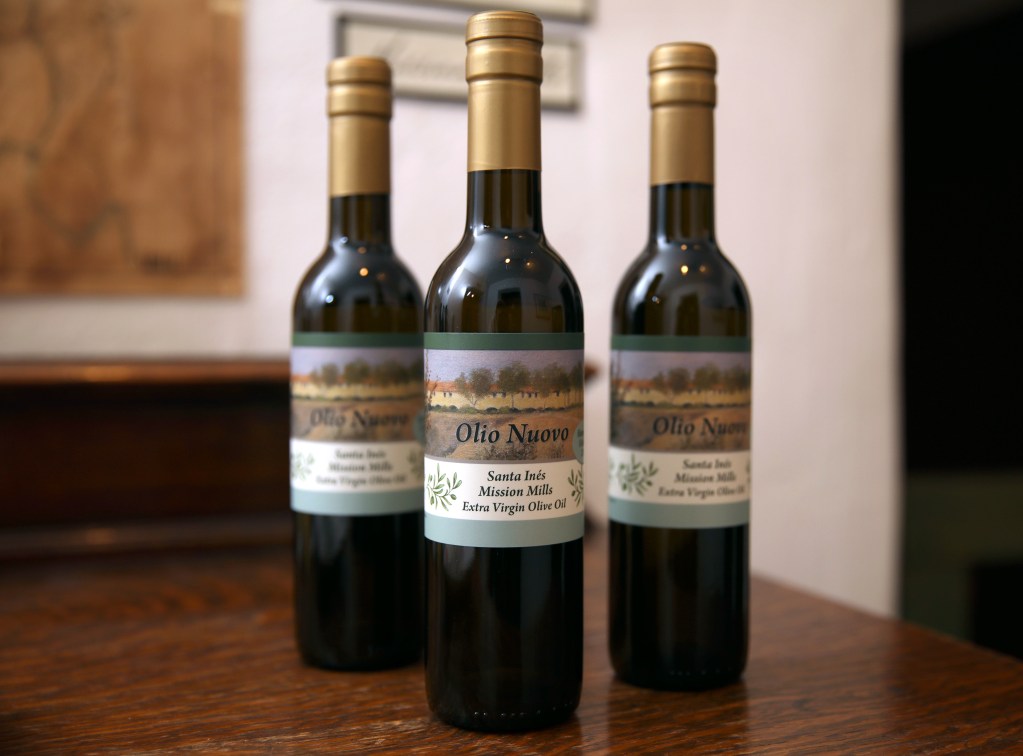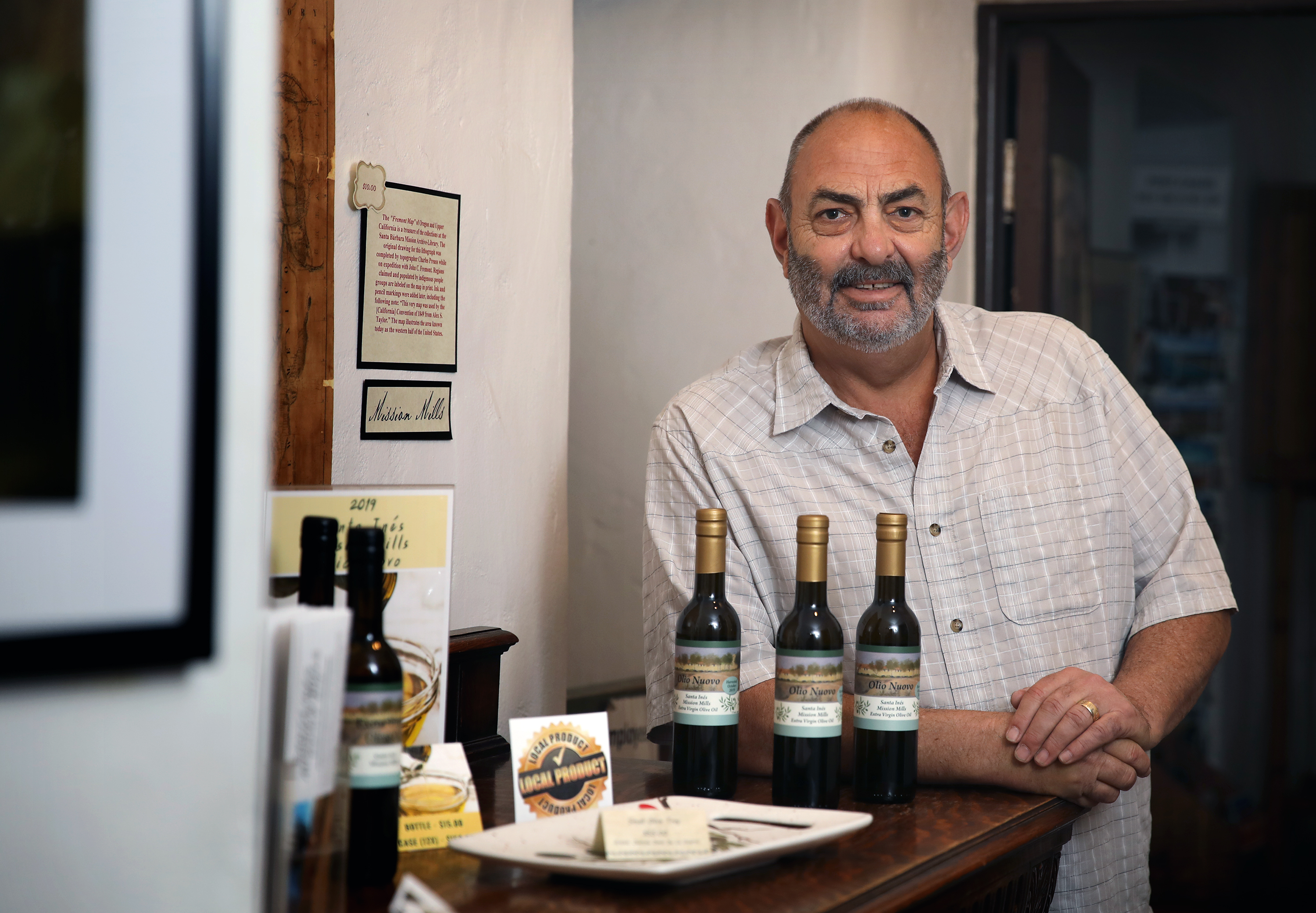On an average day, Michael Imwalle’s job typically involves a lot of paperwork and phone calls. As the associate executive director for cultural resources at the Santa Barbara Trust for Historic Preservation (SBTHP), where he also served as archaeologist for nearly 30 years, Imwalle oversees the property management and maintenance of some of Santa Barbara’s most beloved historic landmarks.
Get the top stories in your inbox by signing up for our daily newsletter, Indy Today.
But every fall season, Imwalle steps out of his office for something that isn’t exactly in his job description: leading the production of one of the freshest olive oils in the world. Called Olio Nuovo, the oil is produced from a blend of five olive varieties — Arbequina, Grappolo, Lucca, Manzanillo, and Mission — that are harvested on the grounds of the historic Santa Inés Mission Mills. The name “Olio Nuovo,” or “new oil,” reflects that freshness, which can be tried every fall when the oil is released for sale.
“This olive oil is crushed in November, bottled in November, and for sale in November,” said Imwalle. “And it’s gone by the following November.”

Commercial olive oils typically spend most of their lifespan in an impersonal shuffle between warehouses and grocery stores, meaning that most are more than a year old before they reach customers. In contrast, the Olio Nuovo project is a community-driven effort: Volunteers help harvest ripe olives each fall, and within 48 hours, the olives are crushed and bottled only 30 miles away at Figueroa Farms in Santa Ynez.
The result is an extra virgin olive oil loved not only for its distinct grassy and peppery taste, but also for its nutritional benefits. Crushed olives produce a nutritious sediment that ordinarily sinks to the bottom of the barrel in other operations. Because the Olio Nuovo olive oil is bottled before the oil even settles, each bottle is packed with particles containing antioxidants and heart-healthy polyphenols.
The key to achieving the optimal flavor and nutrition lies in picking the olives when they’re perfectly ripe — right between green and black in color. “The green olives produce a lot of the really tangy flavor and antioxidants that are really good for you, and the black olives produce smoother oil,” Imwalle explained. “It’s a combination of those two that we like: a smooth oil with a sharp flavor.”
That also means that harvesting is an incredibly time-sensitive operation. The olive oil becomes more mellow as the olives ripen, so even a day’s delay can greatly alter its flavor. Couple that with the fact that the harvest season occurs during late fall when bad weather begins, and producing the oil is no easy feat.
Coming up on the project’s 12th harvest this fall, the olive oil production has increased from 30.5 to nearly 150 gallons of oil. Its origins trace back to the early 1990s, when the former owners of the mill planted 78 Manzanillo-variety olive trees on the property. In 2007, the Santa Inés Mission Mill Committee and the SBTHP Board of Directors decided to plant additional olive trees and begin an independent olive oil operation to provide an income stream to support the organization.
The operation reflects the agricultural history of the site. The Santa Inés Mission Mill is where olives were first introduced to the Santa Ynez Valley in the 1800s, and olive trees were a common fixture on missions at the time. “The idea was to plant something that was in communion with the Spanish colonial agricultural industries,” Imwalle said.
Although harvest only occurs once a year, caring for the olives is a year-round process. The trust’s agricultural and maintenance supervisors, Tom Walton and Leanne Haslouer-Walton, live on-site and mow, irrigate, and prune the trees daily. That also includes protecting the trees from pests like the Mediterranean olive fly, which implants its seeds in the fruit of the olive and necessitates vigilant pesticide treatment.
The Waltons’ efforts culminate in an annual community picking day manned by volunteers, who also receive a free lunch and tour of the site. The event provides the trust with a way to engage with the community and spread awareness of the mill’s historical significance.
“Every year, the turnouts have gotten bigger and bigger,” Imwalle said. “Hopefully, we’ll be able to do it again this year in October without having too many restrictions because it’s a good social distancing activity.”
411| Olio Nuovo can be ordered for curbside pickup from the gift shop at El Presidio de Santa Barbara State Historic Park (123 E. Canon Perdido St.) by ordering online at sbthp.org or calling (805) 965-0093.
At the Santa Barbara Independent, our staff is working around the clock to cover every aspect of this crisis — sorting truth from rumor. Our reporters and editors are asking the tough questions of our public health officials and spreading the word about how we can all help one another. The community needs us — now more than ever — and we need you in order to keep doing the important work we do. Support the Independent by making a direct contribution or with a subscription to Indy+.





You must be logged in to post a comment.